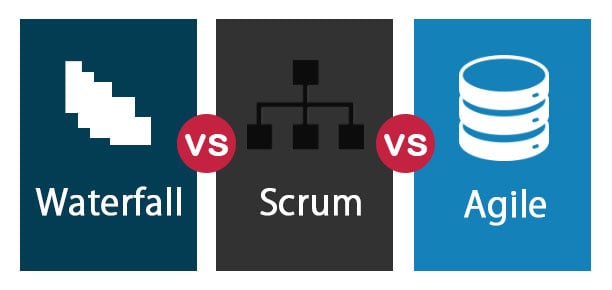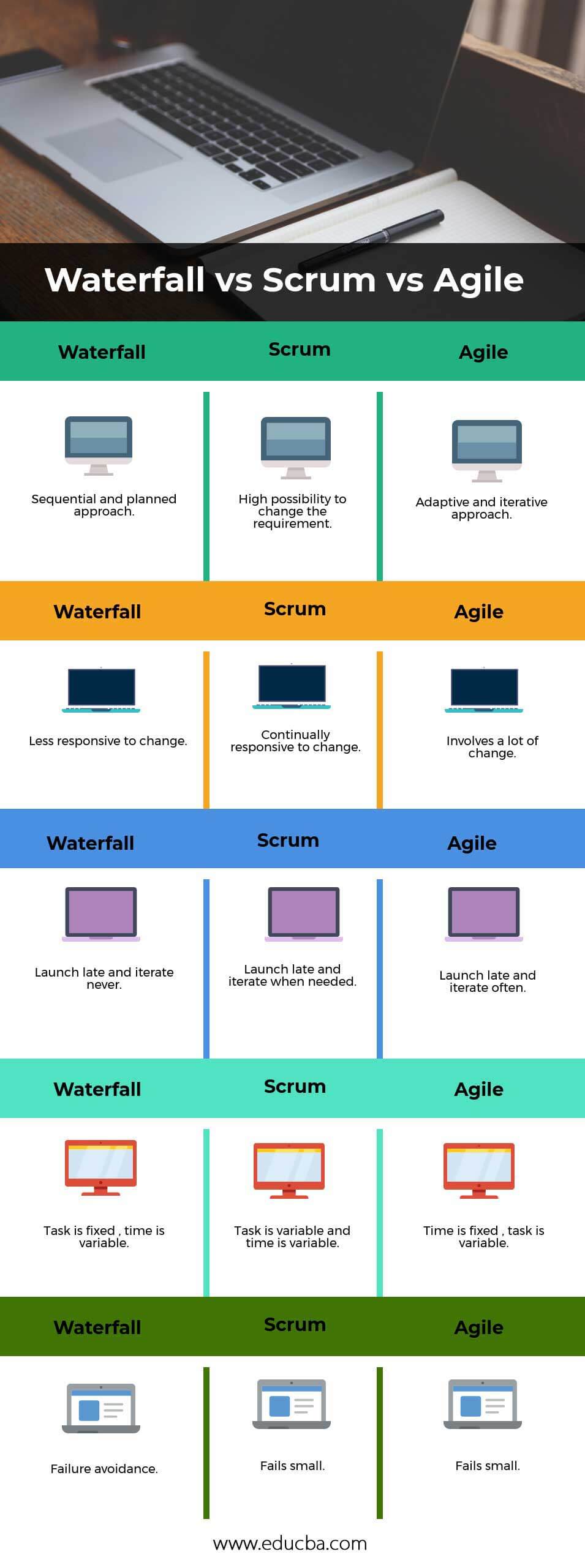
Difference Between Agile vs Scrum vs Waterfall
Agile software development is an iterative approach. In-depth planning of the project beginning will not be carried out and instead encourages changing requirements and constant feedback from the users; for some time, cross-functional teams work iteratively, and this work is prearranged into an accumulation that is prioritized based on customer value. A working product is expected in every iteration. Being a part of Agile is one of the significant setups that led to agile evolution.
It allows complex software and product development to work on an iterative approach. Fixed iterations that exist for one or two weeks are carried out, and they are named sprints, allowing for shipping software on a regular accent. The following steps are decided at the end of each sprint. Waterfall methodology follows a chronological, linear procedure and is the most popular version of the SDLC in engineering and IT projects. Once each stage is completed, the development progresses toward the next step. In this process, it is not possible to achieve the movement of the previous stage, and the entire process must be restarted from the beginning. We will review and approve the requirements at every stage of the process.
Principles of Agile Manifesto
- Customer satisfaction through continuous valuable software delivery
- Fit-in requirement changes in the phase of development
- Shooter delivery scale
- Collaborations within business teams and developers daily
- Deliver Greater support, trust, and higher autonomy to the team members.
- Face-to-face communication significantly facilitates the transmission of information within a development team.
- working software measures the progress of the project
- Maintaining a constant pace provides sustainable development
- The main focus is Technical excellence.
- The teams should reproduce to be effectively regularly
Major Principles of the scrum manifesto
- Empirical Process Control: Transparency, inspection, and adaptation are the three key concepts that form the foundation of Scrum and Scrum ceremonies.
- Self-organization: This principle focuses on delivering significantly superior value when self-organized, providing better buy-in and an inventive and imaginative environment that contributes more to growth.
- Collaboration: It expects articulation, awareness, and appropriation. Project management is a value-creation process, delivering more excellent value through teamwork and interactions.
- Value-based Prioritization: This principle focuses on how Scrum helps to deliver maximum business value from the early stages of the project and continues all through.
- Time-boxing: This describes the role of time in a scrum and manages time elements effectively. Time-boxed elements in Scrum include Daily Standup Meetings, Sprints, Sprint Review Meetings, and Sprint Planning Meetings.
- Iterative Development: This principle defines iterative development as how changes can be managed better, and customer needs are satisfied with built products.
Advantages of the waterfall model
- Easily manageable process
- Every phase in the Waterfall has a start and endpoint, and it’s easy to share progress with stakeholders and customers.
- It always expects a documented procedure
Head To Head Comparison Between Agile vs Scrum vs Waterfall(Infographics)
Below is the top 5 difference between Agile vs Scrum vs Waterfall
Key Differences Between Agile vs Scrum vs Waterfall
Both Agile vs Scrum vs Waterfall are popular choices in the market; let us discuss some of the significant Difference Between Agile vs Scrum vs Waterfall
- The Waterfall provides more confidence in what is going to be delivered very priorly itself. Agile works on the best practices of a development environment. Constant review of output in the project enables the handling of several risks effectively.
- When using the waterfall methodology, the team members and project do not require being in the exact physical location. At the same time, agile and Scrum expect the co-location of workers.
- Agile settles with a lesser rework of projects; also, changes should be picked up much earlier. Scrum also allows earlier identification of changes, whereas Waterfall doesn’t react similarly.
- Agile and Scrum provide a smaller blueprint for the end product. This makes a pain point regarding the stated commitments to the customer. At the same time, the waterfall picture is a better image of the end product to the customers and developers.
- All these methodologies have their tools for managing and modeling their development tasks.
Agile vs Scrum vs Waterfall Comparison Table
Below is the topmost comparison between Agile vs Scrum vs Waterfall
|
Waterfall |
Scrum |
Agile |
| The sequential and planned approach | High possibility of changing the requirement | An adaptive and iterative approach |
| Less responsive to change | Continually responsive to change | It involves a lot of change |
| Launch date and iterate never | Set a launch date and iterate as necessary. | Launch date and iterate often |
| A task is fixed, and time is variable | A task is variable, and time is variable | The time remains constant, even though tasks may vary. |
| Failure avoidance | Fails small | Fails small |
Conclusion- Agile vs Scrum vs Waterfall
Agile and Waterfall are very different end products. Almost all types of IT projects can apply the Waterfall methodology, while Agile and Scrum methodologies have restrictions based on the type of project they involve.
Recommended Articles
This has been a guide to the top difference between Agile vs Scrum vs Waterfall. Here we also discuss the key differences between Agile vs Scrum vs Waterfall with infographics and a comparison table. You may also have a look at the following articles to learn more.



